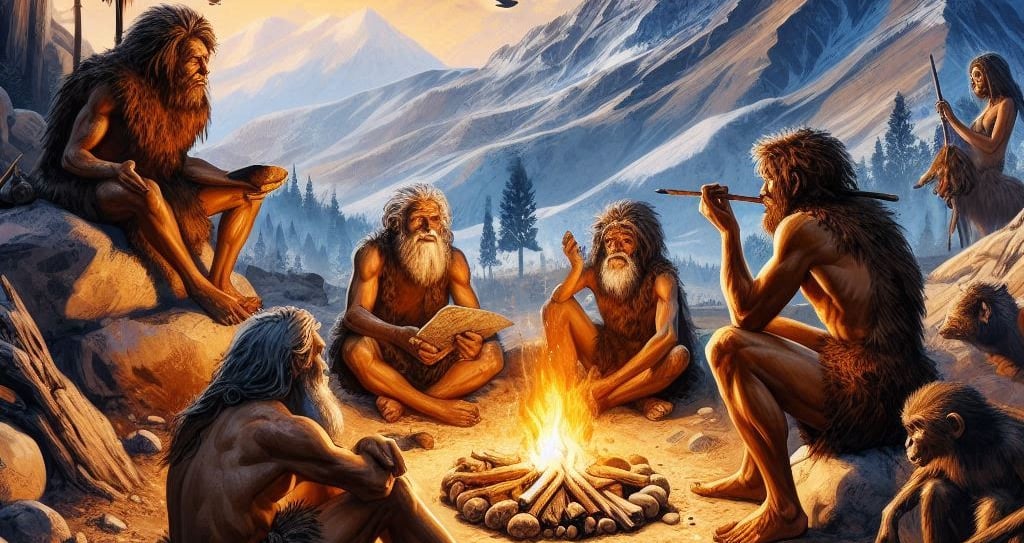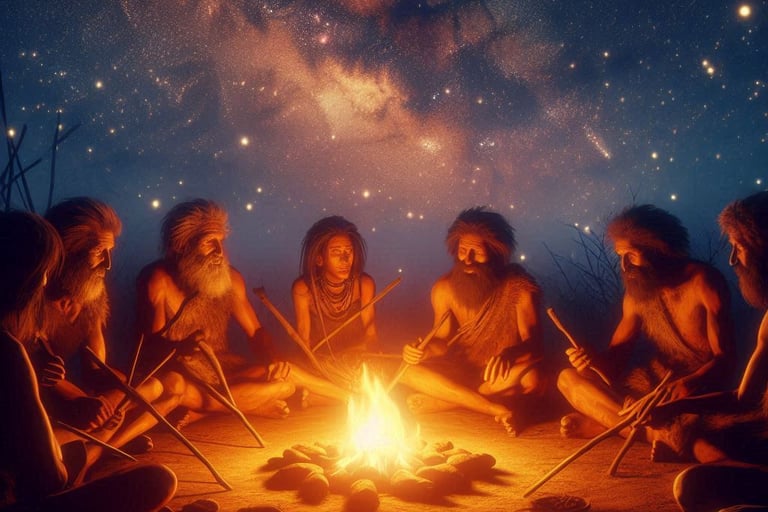Add your promotional text...
The Man-Environment Interaction
MODULE -1: HUMAN AND THE ENVIRONMENT (PART - 1 )
11/22/2024


# Humans as Hunter-Gatherers:
· Lifestyle: Early humans lived by hunting animals and gathering wild plants for food. They were nomadic, moving from place to place in search of resources.
· Tools and Skills: They developed tools made of stone, bone, and wood to aid in hunting and gathering. Skills such as tracking animals and identifying edible plants were crucial for survival.
· Social Structure: Hunter-gatherer societies were typically small, consisting of family groups or tribes. They had a communal way of life, sharing resources and responsibilities.
· Environmental Impact: Their impact on the environment was minimal compared to later agricultural societies. They relied on natural resources without significantly altering the landscape.
· Adaptation: Hunter-gatherers adapted to various environments, from forests and grasslands to deserts and coastal areas, showcasing their resilience and ingenuity.
Ø Mastery of Fire:


· Discovery and Control: Early humans discovered how to create and control fire, which was a monumental achievement in human history.
· Uses of Fire:
o Cooking: Fire allowed humans to cook food, making it safer to eat and easier to digest. This led to better nutrition and health.
o Warmth: Fire provided warmth, which was crucial for survival in colder climates.
o Protection: Fire could be used to ward off predators and insects, offering a sense of security.
o Tool Making: Fire was used to harden wooden tools and shape stones, improving their effectiveness.
o Land Management: Early humans used fire to clear land for hunting and later for agriculture, which began to shape the environment.
· Social and Cultural Impact: The ability to gather around a fire fostered social interactions and community bonding. It also allowed for the development of storytelling and the sharing of knowledge.
· Environmental Impact: While the initial impact was minimal, the use of fire for land management began to alter landscapes and ecosystems.
Ø Origin of Agriculture:
· Transition from Hunter-Gatherer to Farming:
o Around 12,000 years ago, humans began to transition from a nomadic lifestyle of hunting and gathering to settled farming communities.
o This shift allowed for the domestication of plants and animals, leading to more reliable food sources.
· Early Agricultural Practices:
o The earliest evidence of agriculture comes from the Fertile Crescent in the Near East, where crops like wheat and barley were first cultivated.
o Other regions, such as China, Southeast Asia, and the Americas, also independently developed agriculture, cultivating crops like rice, maize, and potatoes.
· Domestication of Plants and Animals:
o Early farmers selected and bred plants and animals for desirable traits, leading to domesticated species that were more productive and easier to manage.
o Key domesticated plants included grains, legumes, and tubers, while animals like sheep, goats, and cattle were also domesticated for food, labor, and other uses.
· Impact on Human Societies:
o Agriculture allowed for the development of permanent settlements, leading to the rise of complex societies and civilizations.
o It also led to significant environmental changes, such as deforestation and soil cultivation, which altered natural landscapes.
· Technological and Cultural Advancements:
o The surplus food produced by agriculture supported larger populations and led to technological innovations, such as irrigation and ploughing.
o It also fostered cultural developments, including the creation of written records, trade networks, and social hierarchies.
Ø Emergence of City-States:
· Definition: City-states are independent, self-governing cities that also control surrounding territories. They were among the earliest forms of organized government and society.
· Historical Context:
o Mesopotamia: One of the earliest examples of city-states emerged in Mesopotamia (modern-day Iraq) around 3000 BCE. Cities like Ur, Uruk, and Babylon were prominent.
o Ancient Greece: Greece is famous for its city-states, known as polis. Athens and Sparta are the most well-known examples, each with its own government, laws, and customs.
o Mesoamerica: In regions like the Maya civilization, city-states such as Tikal and Palenque were significant centres of power and culture.
· Characteristics:
o Political Independence: Each city-state had its own government and operated independently from others.
o Economic Activity: They were centres of trade, craft production, and agriculture, often controlling surrounding rural areas to support their populations.
o Cultural Development: City-states were hubs of cultural and intellectual activity, fostering advancements in art, architecture, literature, and philosophy.
o Military Power: Many city-states maintained their own armies and engaged in warfare with neighbouring city-states or external enemies.
· Significance:
o Innovation and Progress: The concentration of resources and people in city-states led to significant technological and cultural advancements.
o Foundation of Modern Cities: The concept of city-states laid the groundwork for the development of modern cities and urban governance.
Ø Great Ancient Civilizations and the Environment:
· Mesopotamia:
o Location: Between the Tigris and Euphrates rivers (modern-day Iraq).
o Environmental Interaction: Developed irrigation systems to manage river flooding and support agriculture.
o Impact: Intensive farming led to soil salinization, affecting agricultural productivity over time.
· Ancient Egypt:
o Location: Along the Nile River.
o Environmental Interaction: Utilized the Nile’s annual flooding to enrich soil for farming.
o Impact: Built monumental structures like pyramids, which required significant natural resources and labor.
· Indus Valley Civilization:
o Location: Along the Indus River (modern-day Pakistan and northwest India).
o Environmental Interaction: Advanced urban planning with sophisticated drainage and water management systems.
o Impact: Environmental changes, such as river course shifts, may have contributed to the civilization’s decline.
· Ancient China:
o Location: Along the Yellow and Yangtze rivers.
o Environmental Interaction: Developed terrace farming to manage hilly terrain and prevent soil erosion.
o Impact: Deforestation and intensive agriculture led to soil degradation and flooding issues.
· Ancient Greece:
o Location: Mediterranean region.
o Environmental Interaction: Relied on maritime trade and agriculture, adapted to the rocky terrain.
o Impact: Overgrazing and deforestation led to soil erosion and reduced agricultural productivity.
· Ancient Rome:
o Location: Cantered around the Mediterranean Sea.
o Environmental Interaction: Built extensive road networks, aqueducts, and urban infrastructure.
o Impact: Large-scale deforestation and mining activities had significant environmental consequences.
Ø Middle Ages:
· Time Period: Roughly from the 5th to the late 14th century, following the fall of the Roman Empire.
· Feudal System: Society was structured around feudalism, where land was exchanged for military service. The king granted land to nobles, who in turn provided protection and land to peasants.
· Role of the Church: The Catholic Church was the most powerful institution, influencing all aspects of life, including politics, education, and art.
· Daily Life: Most people lived in rural areas and worked as farmers. Towns and cities were small and often cantered around a castle or monastery.
· Cultural and Scientific Stagnation: Often referred to as the “Dark Ages,” this period saw fewer advancements in science and culture compared to the Renaissance. However, this view is somewhat exaggerated as there were still significant developments, especially in the later Middle Ages.
· Major Events: The Crusades, the Black Death, and the Hundred Years’ War were significant events that shaped the Middle Ages.
Ø Renaissance:
· Time Period: Spanning from the 14th to the 17th century, the Renaissance marked the transition from the Middle Ages to modern history.
· Cultural Revival: The Renaissance was characterized by a renewed interest in classical antiquity, particularly the art, literature, and philosophy of ancient Greece and Rome.
· Humanism: This intellectual movement emphasized the value of human potential and achievements. It encouraged a focus on secular subjects and the study of classical texts.
· Art and Science: The period saw remarkable advancements in art, with figures like Leonardo da Vinci, Michelangelo, and Raphael. Scientific exploration also flourished, with significant contributions from Copernicus, Galileo, and others.
· Technological Innovations: The invention of the printing press by Johannes Gutenberg around 1440 revolutionized the spread of knowledge, making books more accessible and promoting literacy.
· Exploration: The Renaissance era was also a time of exploration, with figures like Christopher Columbus and Vasco da Gama expanding European knowledge of the world.
· Economic and Political Changes: The growth of trade and commerce led to the rise of wealthy merchant classes and the decline of feudalism. City-states like Florence and Venice became powerful economic and cultural centres.
Ø Industrial Revolution and Its Impact on the Environment:
· Overview:
o The Industrial Revolution, beginning in the late 18th century, marked a major turning point in history. It transitioned societies from agrarian economies to industrialized ones, driven by advancements in technology and manufacturing.
· Positive Impacts:
o Economic Growth: The revolution spurred unprecedented economic growth, increased production, and improved living standards for many.
o Technological Advancements: Innovations in machinery, transportation (like railways and steamships), and communication (such as the telegraph) transformed industries and daily life.
· Negative Environmental Impacts:
o Air Pollution: The widespread use of coal and other fossil fuels led to significant air pollution. Factories and power plants emitted large amounts of smoke and pollutants, contributing to poor air quality and health issues.
o Water Pollution: Industrial waste was often dumped into rivers and streams, contaminating water sources and harming aquatic life.
o Deforestation: The demand for raw materials and land for factories and urban expansion led to extensive deforestation, reducing biodiversity and altering ecosystems.
o Soil Degradation: Industrial activities, including mining and chemical use, contaminated soil and reduced its fertility.
o Climate Change: The increased burning of fossil fuels released large amounts of carbon dioxide and other greenhouse gases, contributing to global warming and climate change.
· Long-Term Consequences:
o Biodiversity Loss: Habitat destruction and pollution led to the decline of many species and ecosystems.
o Health Issues: Air and water pollution caused respiratory and other health problems among populations living near industrial areas.
o Urban Overcrowding: Rapid industrialization led to the growth of cities, often resulting in overcrowded and unsanitary living conditions.
Ø Population Growth and Natural Resource Exploitation:
· Population Growth:
o Historical Trends: Human population has grown exponentially, especially since the Industrial Revolution. Advances in medicine, agriculture, and technology have significantly reduced mortality rates and increased life expectancy.
o Current Trends: The global population continues to rise, though the rate of growth has slowed in some regions. As of 2024, the world population is over 8 billion.
· Impact on Natural Resources:
o Increased Demand: More people require more resources, including food, water, energy, and raw materials. This increased demand puts pressure on natural resources.
o Agricultural Expansion: To feed a growing population, more land is converted to agriculture, leading to deforestation, habitat loss, and soil degradation.
o Water Usage: Higher population densities increase the demand for fresh water, leading to over-extraction of rivers, lakes, and aquifers. This can result in water scarcity and stress on aquatic ecosystems.
o Energy Consumption: Growing populations and industrial activities increase the demand for energy, often relying on fossil fuels. This contributes to air pollution and climate change.
o Mineral and Material Extraction: The need for construction materials, metals, and other resources leads to extensive mining activities, which can cause environmental degradation and pollution.
· Environmental Consequences:
o Deforestation: Clearing forests for agriculture and urban development reduces biodiversity and disrupts ecosystems.
o Pollution: Increased industrial and agricultural activities lead to air, water, and soil pollution, affecting human health and the environment.
o Climate Change: The burning of fossil fuels for energy releases greenhouse gases, contributing to global warming and climate change.
o Resource Depletion: Over-exploitation of resources can lead to their depletion, making them unavailable for future generations.
· Sustainable Solutions:
o Resource Management: Implementing sustainable practices in agriculture, forestry, and fisheries to ensure resources are used efficiently and conserved for the future.
o Renewable Energy: Transitioning to renewable energy sources like solar, wind, and hydro to reduce reliance on fossil fuels and mitigate climate change.
o Conservation Efforts: Protecting natural habitats and biodiversity through conservation programs and protected areas.
o Population Control: Promoting family planning and education to manage population growth and reduce pressure on resources.
Ø Global Environmental Change:
· Definition: Global environmental change refers to significant alterations in the Earth’s natural systems, including the atmosphere, hydrosphere, biosphere, and geosphere, often driven by human activities.
· Key Components:
o Climate Change: The long-term alteration of temperature and typical weather patterns in a place. Human activities, particularly the burning of fossil fuels, have increased concentrations of greenhouse gases, leading to global warming.
o Ozone Layer Depletion: The thinning of the Earth’s ozone layer caused by the release of chemicals like chlorofluorocarbons (CFCs). This layer protects life on Earth from harmful ultraviolet (UV) radiation.
o Deforestation: The large-scale removal of forests, which affects biodiversity, carbon storage, and the water cycle. It is often driven by agricultural expansion, logging, and urban development.
o Biodiversity Loss: The decline in the number and variety of species in a particular habitat. This can result from habitat destruction, pollution, overexploitation, and climate change.
o Pollution: The introduction of harmful substances or products into the environment. This includes air, water, and soil pollution, which can have detrimental effects on human health and ecosystems.
o Ocean Acidification: The ongoing decrease in the pH of the Earth’s oceans, caused by the uptake of carbon dioxide (CO₂) from the atmosphere. This affects marine life, particularly organisms with calcium carbonate shells or skeletons.
· Causes:
o Industrial Activities: Emissions from factories, power plants, and vehicles contribute to air and water pollution and greenhouse gas emissions.
o Agricultural Practices: Use of fertilizers and pesticides, deforestation for farmland, and livestock production contribute to pollution, habitat loss, and greenhouse gas emissions.
o Urbanization: Expansion of cities leads to habitat destruction, increased waste production, and higher energy consumption.
o Resource Exploitation: Overfishing, mining, and deforestation deplete natural resources and disrupt ecosystems.
· Consequences:
o Extreme Weather Events: Increased frequency and intensity of hurricanes, droughts, floods, and heatwaves.
o Sea Level Rise: Melting ice caps and glaciers contribute to rising sea levels, threatening coastal communities and ecosystems.
o Health Impacts: Air and water pollution can lead to respiratory and cardiovascular diseases, while climate change can exacerbate the spread of infectious diseases.
o Economic Costs: Damage to infrastructure, loss of agricultural productivity, and increased healthcare costs due to environmental changes.
· Mitigation and Adaptation:
o Renewable Energy: Transitioning to solar, wind, and other renewable energy sources to reduce greenhouse gas emissions.
o Conservation Efforts: Protecting natural habitats, restoring degraded ecosystems, and promoting biodiversity.
o Sustainable Practices: Implementing sustainable agriculture, forestry, and fishing practices to reduce environmental impact.
o Policy and Regulation: Enforcing environmental laws and international agreements, such as the Paris Agreement, to limit emissions and protect natural resources.
o Public Awareness and Education: Raising awareness about environmental issues and encouraging sustainable behaviors among individuals and communities.
Asst. Prof. S.B. Mache
Author & Co-founder of SkratchCodes.in


